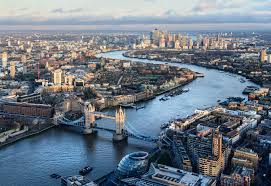DỊCH HOÀN THIỆN ĐỀ THI IELTS READING VÀ GIẢI THÍCH ĐÁP ÁN -
Early occupations around the river Thames
A
In her pioneering survey, Sources of London English, Laura Wright has listed the variety of medieval workers who took their livings from the river Thames. The baillies of Queenhithe and Billingsgate acted as customs officers. There were conservators, who were responsible for maintaining the embankments and the weirs, and there were the garthmen who worked in the fish garths (enclosures). Then there were galleymen and lightermen and shoutmen, called after the names of their boats, and there were hookers who were named after the manner in which they caught their fish. The searcher patrolled the Thames in search of illegal fish weirs, and the tideman worked on its banks and foreshores whenever the tide permitted him to do so.
Trong khảo sát tiên phong, Sources of London English, Laura Wright đã liệt kê nhiều công nhân thời cổ đã kiếm sống từ dòng sông Thames. Những người nhận giữ hàng của Queenhithe và Billingsgate đóng vai trò như nhân viên hải quan. Có những người bảo vệ chịu trách nhiệm bảo dưỡng các con đê và đập nước và người coi giữ đập làm việc trong các đập cá ( các khu khép kín). Sau đó là người chèo thuyền và thợ giữ lửa ( trên tàu thuyền) và người la hét được gọi theo tên của những chiếc thuyền của họ và có những người đánh cá trên thuyền nhỏ được gọi theo cách mà họ bắt cá. Người thăm dò đi tuần tra sông Thames tìm kiếm các đập cá trái phép và người canh thủy triều làm việc trên các bờ sông và ngoài khơi ở bất cứ nơi nào mà thủy triều cho phép anh ta làm việc.
B
All of these occupations persisted for many centuries, as did those jobs that depended upon the trade of the river. Yet, it was not easy work for any of the workers. They carried most goods upon their backs, since the rough surfaces of the quays and nearby streets were not suitable for wagons or large carts; the merchandise characteristically arrived in barrels which could be rolled from the ship along each quay. If the burden was too great to be carried by a single man, then the goods were slung on poles resting on the shoulders of two men. It was a slow and expensive method of business.’
Tất cả những nghề này tồn tại qua nhiều thế kỷ, như chính những nghề đã phụ thuộc vào việc buôn bán của con sông. Tuy nhiên, nó không phải là công việc dễ dàng cho bất kỳ người lao động nào. Họ mang vác nhiều hàng hóa trên vai, vì bề mặt gồ ghề của cầu cảng và đường xá gần đó không phù hợp cho xe ngựa và xe kéo hàng lớn bằng tay; hàng hóa cập cảng theo cách đặc trưng trong các thùng có thể được lăn từ tàu theo mỗi cầu cảng. Nếu trọng lượng quá nặng để một người đàn ông có thể vác thì hàng hóa được treo trên những cái sào đặt trên vai của hai người đàn ông. Đó là một phương pháp làm việc tốn sức và chậm chạp.
>>>>>Xem thêm:
♦ Tổng hợp câu trả lời, câu hỏi, từ vựng của hơn 70 chủ đề Ielts Speaking part 1
♦ Tổng hợp gần 400 đề thi Ielts reading ( bao gồm dịch, giải chi tiết, từ vựng)
C
However, up to the eighteenth century, river work was seen in a generally favourable light. For Langland, writing in the fourteenth century, the labourers working on river merchandise were relatively prosperous. And the porters of the seventeenth and early eighteenth centuries were, if anything, aristocrats of labour, enjoying high status. However, in the years from the late eighteenth to the early nineteenth century, there was a marked change in attitude. This was in part because the working river was within the region of the East End of London, which in this period acquired an unenviable reputation. By now, dockside labour was considered to be the most disreputable, and certainly the least desirable form of work.
Tuy nhiên, đến tận thế kỷ 18, những công việc ở sông được nhìn nhận theo quan điểm nói chung là có triển vọng. Đối với Langland, viết vào thế kỷ 14, người lao động làm việc với hàng hóa bờ sông tương đối phát đạt. Và người khuân vác của thế kỷ 17 và đầu thế kỷ 18 ngược lại là những quý tộc của lao động tay chân, hưởng địa vị cao. Tuy nhiên trong những năm từ cuối thế kỷ 18 đến đầu thế kỷ 19, có những thay đổi rõ rệt trong quan điểm. Một phần bởi vì con sông đang hoạt động nằm trong khu vực East End của London, nơi mà trong thời kỳ này nổi tiếng là không ai mong muốn. Từ đó đến giờ lao động bến cảng được xem như là nhơ nhuốc nhất và chắc chắn là kiểu công việc ít mong muốn nhất.
D
It could be said that the first industrial community in England grew up around the Thames. With the host of river workers themselves, as well as the vast assembly of ancillary trades such as tavern-keepers and laundresses, food-sellers and street-hawkers, shopkeepers and marine store dealers - there was a workforce of many thousands congregated in a relatively small area. There were more varieties of business to be observed by the riverside than, in any other part of the city. As a result, with the possible exception of the area known as Seven Dials, the East End was also the most intensively inhabited region of London.
E
It was a world apart, with its own language and its own laws. From the sailors in the opium dens of Limehouse to the smugglers on the malarial flats of the estuary, the workers of the river were not part of any civilised society. The alien world of the river had entered them. That alienation was also expressed in the slang of the docks, which essentially amounted to backslang, or the reversal of ordinary words. This backslang also helped in the formulation of Cockney rhyming slang, so that the vocabulary of Londoners was directly affected by the life of the Thames.

1. Mua bộ đề gần 400 bài ielts reading - Dịch và giải chi tiết Chỉ 199k bao gồm toàn bộ đề trong bộ Cambridge ( từ bộ 1 -19) và nhiều đề thi thực tế ( xem danh sách 400 đề ielts reading tại đây). Xem bài mẫu tại đây, Bài mẫu 1, bài mẫu 2, bài mẫu 3. Giải đề bao gồm phần dịch bài đọc, dịch phần câu hỏi, giải thích chi tiết, ( chỉ có thể tải, in phần đề để luyện tập, phần giải chi tiết và dịch chỉ xem online).
>>>> >>>> Đặc biệt tặng kèm Dịch và giải chi tiết bộ đề Ielts listening từ Cam 10-18 và tặng kèm hơn 300 đề Ielts thực tế ( không có lời giải chi tiết chỉ có đề và đáp án) ( khác với bộ 400 đề ở trên). Vui lòng điền thông tin theo form tại đây và thanh toán theo thông tin CK trong form.
2. Đặc biệt dành tặng 100 bạn hoàn thành buổi học thử miễn phí khóa học Ielts Speaking online 1 kèm 1, các bạn sẽ được tặng bộ đề 400k bài Ielts reading và bộ đề Ielts Listening bộ Cam từ 10-18 gồm bài dịch và giải chi tiết, giải thích từ vựng khó ( thời hạn sử dụng trong vòng 2 tháng). Xem thông tin khóa học Ielts Speaking online 1 kèm 1 và đăng ký học thử tại đây.
F
The reports in the nineteenth-century press reveal a heterogeneous world of dock labour, in which the crowds of casuals waiting for work at the dock gates at 7.45 a.m. include penniless refugees, bankrupts, old soldiers, broken-down gentlemen, discharged servants, and ex-convicts. There were some 400-500 permanent workers who earned a regular wage and who were considered to be the patricians of dockside labour. However, there were some 2,500 casual workers who were hired by the shift. The work for which they competed fiercely had become ever more unpleasant. Steam power could not be used for the cranes, for example, because of the danger of fire. So the cranes were powered by treadmills. Six to eight men entered a wooden cylinder and, laying hold of ropes, would tread the wheel round. They could lift nearly 20 tonnes to an average height of 27 feet (8.2 metres), forty times in an hour. This was part of the life of the river unknown to those who were intent upon its more picturesque aspects.
Questions 14-19
Reading Passage 319 has SIX paragraphs, A-F.
Choose the correct heading, A-F, from the list of headings below.
Write the correct number, i-ix, in boxes 14-19 on your answer sheet.
List of Headings
i. A mixture of languages and nationalities
ii. The creation of an exclusive identity
iii. The duties involved in various occupations
iv. An unprecedented population density
v. Imports and exports transported by river
vi. Transporting heavy loads manually
vii. Temporary work for large numbers of people
viii. Hazards associated with riverside work
ix. The changing status of riverside occupations
14. Paragraph A
15. Paragraph B
16. Paragraph C
17. Paragraph D
18. Paragraph E
19. Paragraph F
Questions 20-21
Choose TWO letters, A-E.
Write the correct letters, A-E, in boxes 20 & 21 on your answer sheet.
Which TWO statements are made about work by the River Thames before the eighteenth century?
A. Goods were transported from the river by cart.
B. The workforce was very poorly paid.
C. Occupations were specialised.
D. Workers were generally looked down upon.
E. Physical strength was required.
Questions 22-23
Choose TWO letters, A-E.
Write the correct letters, A-E, in boxes 22 & 23 on your answer sheet.
Which TWO statements are made about life by the River Thames in the early nineteenth century?
A. The area was very crowded.
B. There was an absence of crime.
C. Casual work was in great demand.
D. Several different languages were in use.
E. Inhabitants were known for their friendliness.
Questions 24-26
Complete the sentences below.
Use NO MORE THAN TWO WORDS from the passage for each answer.
24. In the nineteenth century, only a minority of dock workers received a ....................... .
25. Cranes were operated manually because ....................... created a risk of fire.
26. Observers who were unfamiliar with London’s docks found the River Thames ....................... .
ĐÁP ÁN, GIẢI CHI TIẾT và DỊCH HOÀN THIỆN ĐỀ THI IELTS READING:
Early occupations around the river Thames
Questions 14-19
Reading Passage 319 has SIX paragraphs, A-F.
Choose the correct heading, A-F, from the list of headings below.
Write the correct number, i-ix, in boxes 14-19 on your answer sheet.
14. Paragraph A/ iii. The duties involved in various occupations
15. Paragraph B/ vi. Transporting heavy loads manually.
Giải thích:
They carried most goods upon their backs, since the rough surfaces of the quays and nearby streets were not suitable for wagons or large carts; the merchandise characteristically arrived in barrels which could be rolled from the ship along each quay. If the burden was too great to be carried by a single man, then the goods were slung on poles resting on the shoulders of two men.
Questions 20-21
Choose TWO letters, A-E.
Write the correct letters, A-E, in boxes 20 & 21 on your answer sheet.
Which TWO statements are made about work by the River Thames before the eighteenth century?
Hai phát biểu nào về cuộc sống bên bờ sông Thames trước thế kỷ 18
A. Goods were transported from the river by cart.
Hàng hóa được chuyên chở từ sông bằng xe đẩy bằng tay
B. The workforce was very poorly paid.
Lực lượng lao động được trả tiền rất ít
C. Occupations were specialised.
Nghề nghiệp được chuyên môn hóa
Giải thích: đoạn A, công việc được phân chia chuyên môn rõ ràng cho từng công việc như là Baillies thì làm gì, conservators thì làm gì, galleymen thì làm gì ....
In her pioneering survey, Sources of London English, Laura Wright has listed the variety of medieval workers who took their livings from the river Thames. The baillies of Queenhithe and Billingsgate acted as customs officers. There were conservators, who were responsible for maintaining the embankments and the weirs, and there were the garthmen who worked in the fish garths (enclosures). Then there were galleymen and lightermen and shoutmen, called after the names of their boats, and there were hookers who were named after the manner in which they caught their fish. The searcher patrolled the Thames in search of illegal fish weirs, and the tideman worked on its banks and foreshores whenever the tide permitted him to do so.
D. Workers were generally looked down upon.
Công nhân thường bị xem thường
E. Physical strength was required.
Sức mạnh thể chất là cần thiết
Giải thích: đáp án A, E
All of these occupations persisted for many centuries, as did those jobs that depended upon the trade of the river. Yet, it was not easy work for any of the workers. They carried most goods upon their backs, since the rough surfaces of the quays and nearby streets were not suitable for wagons or large carts; the merchandise characteristically arrived in barrels which could be rolled from the ship along each quay.

1. Mua bộ đề gần 400 bài ielts reading - Dịch và giải chi tiết Chỉ 199k bao gồm toàn bộ đề trong bộ Cambridge ( từ bộ 1 -19) và nhiều đề thi thực tế ( xem danh sách 400 đề ielts reading tại đây). Xem bài mẫu tại đây, Bài mẫu 1, bài mẫu 2, bài mẫu 3. Giải đề bao gồm phần dịch bài đọc, dịch phần câu hỏi, giải thích chi tiết, có thể tải về, in phần đề để luyện tập.
>>>> >>>> Đặc biệt tặng kèm Dịch và giải chi tiết bộ đề Ielts listening từ Cam 10-18 và tặng kèm hơn 300 đề Ielts thực tế ( không có lời giải chi tiết chỉ có đề và đáp án) ( khác với bộ 400 đề ở trên). Vui lòng điền thông tin theo form tại đây và thanh toán theo thông tin CK trong form.
2. Đặc biệt dành tặng 100 bạn hoàn thành buổi học thử miễn phí khóa học Ielts Speaking online 1 kèm 1, các bạn sẽ được tặng bộ đề 400k bài Ielts reading và bộ đề Ielts Listening bộ Cam từ 10-18 gồm bài dịch và giải chi tiết, giải thích từ vựng khó ( thời hạn sử dụng trong vòng 2 tháng). Xem thông tin khóa học Ielts Speaking online 1 kèm 1 và đăng ký học thử tại đây.
Answer:
14. iii
15. vi
16. ix
17. iv
18. ii
19. vii
20. & 21. C, E [in either order]
22. & 23. A, C [in either order]
24. regular wage
25. steam power
26. picturesque

.png)





